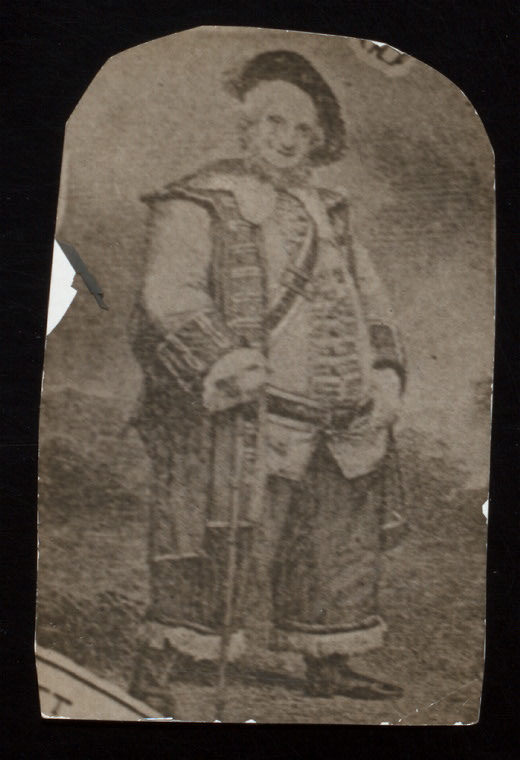Archives
Falstaff On the Road: Or, Why Dickens Was Right About America
Shakespeare’s Star Turn in America focuses on production of Shakespeare’s works in North American theaters and why certain plays were popular at specific times. However, it became obvious in our research that some plays are popular because actors want to do them. A prime example of this phenomenon is the almost constant production of the Falstaff plays—King Henry IV, Parts 1 and 2, as well as The Merry Wives of Windsor. There are two prime examples of actors and actor/managers who based their later careers on performing Sir John Falstaff.
James H. Hackett played Falstaff over at least 30 years. The exhibition includes broadsides for King Henry IV, Part 1, from the Park Theatre, NY, on March 20, 1839, and from Booth’s Theatre, NY, for December 31, 1869. He was featured in Johnson & Fry engravings for the Henry plays and a Hollies engraving after a daguerreotype by Mayall. The poses are similar to the one above, although in the second, he wears the antler headdress from The Merry Wives of Windsor. Fun fact: His son, James K. Hackett, also had a long careeer with one role, but he played the identical cousins, Rudolph and Rupert, in the stage and silent film adaptations of Antony Hope's The Prisoner of Zenda. My second ever post (April 2010) was about his portrait in the recognizable Zenda pose.
Benedict de Bar played Falstaff at his own theaters and opera houses along his Mississippi and Missouri River circuits in the 1860s and 1870s. His broadsides include a roundel of him in that character, probably based on his portrait in profile.
So what does this have to do with Dickens? They would say “nothing.” He would claim “American plagiarism!” Charles Dickens was famously upset that his novels were adapted, re-published and ripped-off by American publishers. Did he ever know about the Falstaffs?
One of the pleasures of seeing Shakespeare in the 18th through mid-19th centuries was that the program also included an afterpiece and frequently solos and duets by other members of their companies. So we know what else was on the program with these productions of Henry IV.
Ben de Bar had shown up in my Touring West research so I knew to request his bright yellow broadsides from New Orleans, Iowa and Memphis (you may have to check a map to understand why his your routes made sense). I had not remembered the afterpiece. He paired performances of King Henry IV with his own Micawber and Toodles. We Googled Toodles (who turns out to be a character in a different Dickens novel) and decided that he meant Traddles, who works with Micawber. The afterpiece was based on the characters in Charles Dickens’s popular novel David Copperfield (published serially in 1849-1850). But Dickens’s name is nowhere to be found on the program.
When Hackett performed as Falstaff in the 1830s, his afterpiece was also an uncredited adaptation. King Henry IV was followed by Nicholas Nickelby, March 20, 1839. The second play, Nicholas Nickelby; or, Doings at Do-the-Boys Hall may have been based on the Edward Stirling adaptation which was performed at the Adelphi Theatre, London, that season, or may have been a native-born adaptation of the novel. It maintains the misspelling of the character's name from the Stirling adaptation.
Something about the dates seemed wrong and we kept double checking that Nickelby appeared on the 1839, not 1869, broadside. It did. But, Charles Dickens’s novel, Nicholas Nickleby, was published serially in chapters 1 – 65 and it was not completely published when the play was done in NY. By even the fastest possible crossing (15 days by steam powered ship), only chapters 1 through 37-39 would have been available in New York for Hackett’s performances. It is amazing what you can find out through NYPL’s electronic resources!
Even assuming that Hackett’s version adapted the Stirling adaptation of episodes in the early chapters, it means that New Yorkers saw the characters before Dickens wrote their fates. Neither Dickens nor Stirling was credited on the program.
Maybe the actors were inspired by Falstaff’s famously loose ethics. Maybe Dickens was right about America's disregard for copyright.
Read E-Books with SimplyE
 With your library card, it's easier than ever to choose from more than 300,000 e-books on SimplyE, The New York Public Library's free e-reader app. Gain access to digital resources for all ages, including e-books, audiobooks, databases, and more.
With your library card, it's easier than ever to choose from more than 300,000 e-books on SimplyE, The New York Public Library's free e-reader app. Gain access to digital resources for all ages, including e-books, audiobooks, databases, and more.
If you don’t have an NYPL library card, New York State residents can apply for a digital card online or through SimplyE (available on the App Store or Google Play).
Need more help? Read our guide to using SimplyE.

Comments
Max Strakosch
Submitted by Arthur Mark (not verified) on April 8, 2016 - 3:32pm